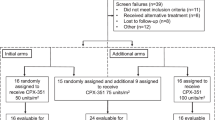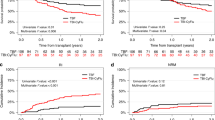Abstract
Using a combination of intensive chemotherapy and G-CSF, we conducted a prospective trial designed to improve the complete remission (CR) rate in patients with AML evolving from a primary documented myelodysplastic syndrome (sAML) and therapy-related AML (tAML). Thirty-four patients (median age 61 years) with sAML (25 patients) or tAML (nine patients) entered the study. Induction course consisted of idarubicin (12 mg/m2 of body-surface area per day for 3 days) and intermediate-dose (ID) cytarabine in the 24 younger patients (1 g/m2 of body-surface area as a 2 h infusion every 12 h for 5 days) or standard-dose (SD) cytarabine in the 10 older patients (100 mg/m2 of body-surface area per day as a continuous infusion for 7 days), followed by G-CSF until neutrophil recovery or treatment failure. Nineteen patients (56%, 13/24 in the ID group and 6/10 in the SD group) achieved a CR (14/25 sAML and 5/9 tAML). Early death occurred in four patients, but four additional patients died in CR from treatment-related toxicity (overall toxic death rate 24%). Initial cytogenetics was available in 33 patients. The CR rate was significantly lower in patients with unfavorable cytogenetics compared to patients with intermediate cytogenetics (37% vs 79%). Median remission duration and overall survival were 3 and 9 months, respectively and not different between ID and SD patients. Although the treatment-related toxicity is high, a high CR rate can be obtained in these poor-risk AML patients with the use of intensive chemotherapy in combination with G-CSF, although the role of the latter is still to be proven. Results remain especially poor in patients with unfavorable cytogenetics. New approaches are needed to maintain remission in these high-risk AML patients.
This is a preview of subscription content, access via your institution
Access options
Subscribe to this journal
Receive 12 print issues and online access
$259.00 per year
only $21.58 per issue
Buy this article
- Purchase on Springer Link
- Instant access to full article PDF
Prices may be subject to local taxes which are calculated during checkout
Similar content being viewed by others
Author information
Authors and Affiliations
Consortia
Rights and permissions
About this article
Cite this article
Gardin, C., Chaibi, P., de Revel, T. et al. Intensive chemotherapy with idarubicin, cytosine arabinoside, and granulocyte colony-stimulating factor (G-CSF) in patients with secondary and therapy-related acute myelogenous leukemia. Leukemia 11, 16–21 (1997). https://doi.org/10.1038/sj.leu.2400536
Received:
Accepted:
Issue Date:
DOI: https://doi.org/10.1038/sj.leu.2400536
Keywords
This article is cited by
-
RETRACTED ARTICLE: LAMP2 expression dictates azacytidine response and prognosis in MDS/AML
Leukemia (2019)
-
Monosomal karyotype predicts poor survival after allogeneic stem cell transplantation in chromosome 7 abnormal myelodysplastic syndrome and secondary acute myeloid leukemia
Leukemia (2013)
-
Therapy-related acute myelogenous leukemia and myelodysplastic syndrome
Current Oncology Reports (2007)
-
Karyotype is an independent prognostic parameter in therapy-related acute myeloid leukemia (t-AML): an analysis of 93 patients with t-AML in comparison to 1091 patients with de novo AML
Leukemia (2004)
-
Combination of liposomal daunorubicin (DaunoXome), fludarabine, and cytarabine (FLAD) in patients with poor-risk acute leukemia
Annals of Hematology (2004)



